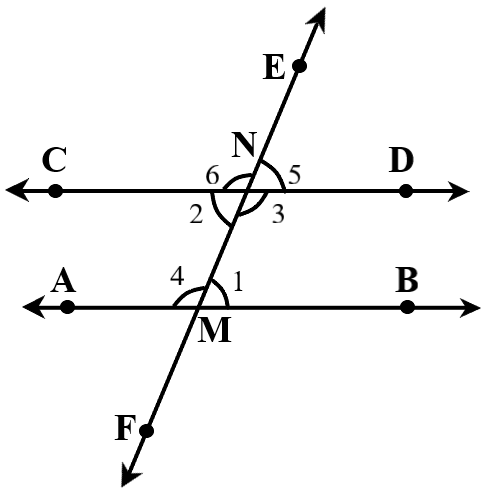
"If a transversal intersects two parallel lines, then each pair of interior angles are supplementary". Prove it.
Answer
489.3k+ views
Hint: Here In this question, we need to prove a given statement. For this, first we need to draw a figure as per given information in question, then use the properties of angles also keep in mind to use the corresponding angles and opposite angles properties of angles, using this information to approach towards the solution of the given problem.
Complete answer:Consider the given statement:
We have to say that "If a transversal intersects two parallel lines, then each pair of interior angles are supplementary".
Let us represent the above statement diagrammatically:

In above diagram lines AB and CD are two parallel lines and EF is a transversal line which intersect both AB and CD line at M and N respectively forming two pairs of interior angles i.e., $$\angle 1$$, $$\angle 3$$ and $$\angle 2$$, $$\angle 4$$.
We need to prove: $$\angle 1 + \angle 3 = {180^ \circ }$$ or $$\angle 2 + \angle 4 = {180^ \circ }$$.
Since ray ND perpendicular on line EF, then$$\angle 3$$ and $$\angle 5$$ are linear pair of angles.
$$\therefore \,\,\,\angle 3 + \angle 5 = {180^ \circ }$$ -----(1)
But line $$AB\parallel CD$$, then $$\angle 1$$ and $$\angle 5$$ are corresponding angles.
$$\therefore \,\,\,\angle 1 = \angle 5$$ -----(2)
Form (1) and (2), we get
$$ \Rightarrow \,\,\,\,\angle 3 + \angle 1 = {180^ \circ }$$ ------(3)
Similarly, ray CN perpendicular on line EF, then $$\angle 2$$ and $$\angle 6$$ are linear pair of angles.
$$\therefore \,\,\,\angle 2 + \angle 6 = {180^ \circ }$$ -----(4)
But line $$AB\parallel CD$$, then $$\angle 4$$ and $$\angle 6$$ are corresponding angles.
$$\therefore \,\,\,\angle 4 = \angle 6$$ -----(5)
Form (4) and (5), we get
$$ \Rightarrow \,\,\,\,\angle 2 + \angle 4 = {180^ \circ }$$ ------(6)
From (3) and (6)
Hence, we can say that "If a transversal intersects two parallel lines, then each pair of interior angles are supplementary".
i.e., $$\angle 1 + \angle 3 = {180^ \circ }$$ or $$\angle 2 + \angle 4 = {180^ \circ }$$.
Note:
For this type of problem, drawing a diagram is more important and it makes proof easy. Remember while identifying the transversal of two lines and corresponding angles we must note that transversal is the line cutting two parallel lines and corresponding angles are angles between lines and transversal on the same side of it.
Complete answer:Consider the given statement:
We have to say that "If a transversal intersects two parallel lines, then each pair of interior angles are supplementary".
Let us represent the above statement diagrammatically:

In above diagram lines AB and CD are two parallel lines and EF is a transversal line which intersect both AB and CD line at M and N respectively forming two pairs of interior angles i.e., $$\angle 1$$, $$\angle 3$$ and $$\angle 2$$, $$\angle 4$$.
We need to prove: $$\angle 1 + \angle 3 = {180^ \circ }$$ or $$\angle 2 + \angle 4 = {180^ \circ }$$.
Since ray ND perpendicular on line EF, then$$\angle 3$$ and $$\angle 5$$ are linear pair of angles.
$$\therefore \,\,\,\angle 3 + \angle 5 = {180^ \circ }$$ -----(1)
But line $$AB\parallel CD$$, then $$\angle 1$$ and $$\angle 5$$ are corresponding angles.
$$\therefore \,\,\,\angle 1 = \angle 5$$ -----(2)
Form (1) and (2), we get
$$ \Rightarrow \,\,\,\,\angle 3 + \angle 1 = {180^ \circ }$$ ------(3)
Similarly, ray CN perpendicular on line EF, then $$\angle 2$$ and $$\angle 6$$ are linear pair of angles.
$$\therefore \,\,\,\angle 2 + \angle 6 = {180^ \circ }$$ -----(4)
But line $$AB\parallel CD$$, then $$\angle 4$$ and $$\angle 6$$ are corresponding angles.
$$\therefore \,\,\,\angle 4 = \angle 6$$ -----(5)
Form (4) and (5), we get
$$ \Rightarrow \,\,\,\,\angle 2 + \angle 4 = {180^ \circ }$$ ------(6)
From (3) and (6)
Hence, we can say that "If a transversal intersects two parallel lines, then each pair of interior angles are supplementary".
i.e., $$\angle 1 + \angle 3 = {180^ \circ }$$ or $$\angle 2 + \angle 4 = {180^ \circ }$$.
Note:
For this type of problem, drawing a diagram is more important and it makes proof easy. Remember while identifying the transversal of two lines and corresponding angles we must note that transversal is the line cutting two parallel lines and corresponding angles are angles between lines and transversal on the same side of it.
Recently Updated Pages
Master Class 11 Accountancy: Engaging Questions & Answers for Success

Master Class 11 Science: Engaging Questions & Answers for Success

Master Class 11 Business Studies: Engaging Questions & Answers for Success

Master Class 11 English: Engaging Questions & Answers for Success

Master Class 11 Computer Science: Engaging Questions & Answers for Success

Master Class 9 General Knowledge: Engaging Questions & Answers for Success

Trending doubts
Why is there a time difference of about 5 hours between class 10 social science CBSE

What is the median of the first 10 natural numbers class 10 maths CBSE

The Equation xxx + 2 is Satisfied when x is Equal to Class 10 Maths

Write a letter to the principal requesting him to grant class 10 english CBSE

A Paragraph on Pollution in about 100-150 Words

State and prove the Pythagoras theorem-class-10-maths-CBSE




